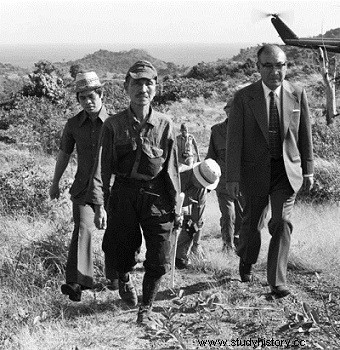
The stragglers (in French "stragglers") is the English word used to designate the Japanese soldiers of the Pacific War who, after the capitulation of Japan in August 1945 which marked the end of the Second World War, continued to fight . They are called in Japanese zanryu nipponhei (literally "remaining Japanese soldiers").
context
The reasons for the continuation of the war are either a strong dogmatism or military principles which prevented them from believing in a defeat, or an ignorance of the end of the war because of communications between these soldiers and Japan cut during the leapfrog strategy used by the United States.
These soldiers continued to fight the occupying forces and later the police, years after the end of the war. Other recalcitrant Japanese soldiers at the end of the war became involved in the Indochina War and the Indonesian National Revolution to liberate Asia from Western presence, one of the goals pursued by the Empire of Japan during the Second World War. World War.
Teruo Nakamura, who lived on Morotai in Indonesia and surrendered in December 1974, is the last confirmed straggler.
Hiro Onoda, who traveled to Lubang Island, Philippines, in March 1974, the penultimate confirmed straggler, died in January 2014.
Japanese soldiers still at war after the end of World War II
1945-1949
Captain Sakae Oba, who led his 46-man company in a guerrilla war against American troops after the Battle of Saipan, did not surrender until December 1, 1945, three months after the war ended.
Major Sei Igawa joins the Viet Minh army as a staff officer. Igawa was killed in battle against the French in 1946
Navy Lieutenant Hideo Horiuchi enlists as Lieutenant Colonel in the Indonesian Volunteer Army. Horiuchi was arrested by Dutch troops on August 13, 1946 while being treated in a village.
Lieutenant Ei Yamaguchi and his 33 soldiers resurfaced in Peleliu at the end of March 1947 by attacking the detachment of Marines stationed on the island. Reinforcements are sent with a Japanese admiral who manages to convince them that the war is over. They finally surrendered in April 1947.
On May 12, 1948, the AP reports that two Japanese soldiers surrendered to Guam police.
Yamakage Kufuku and Matsudo Linsoki, two machine gunners of the Imperial Japanese Navy, surrender at Iwo Jima on January 6, 1949.
1950s
Major Takuo Ishii continues to fight as an adviser to the Viet Minh and chief of staff. Ishii was killed in battle by French soldiers on May 20, 1950.
The AP reported on June 27, 1951 that a Japanese Marine sergeant who had visited Anatahan two weeks earlier claimed that 18 other soldiers were still on the island. A plane from the U.S. Navy which after that flies over the island indeed sees a group of eight or nine Japanese waving white flags on the beach. However the Navy remains cautious because the sergeant had warned that the soldiers were “well armed and that some had threatened to kill everyone if anyone considered surrendering. The leaders say the war is still going on. The Navy sends a boat, the Cocopa, to the island in hopes of picking up some or all of the soldiers without incident. The Japanese occupation of the island will inspire the film Fever on Anatahan.
Private First Class Yuichi Akatsu continued to fight on Lubang from 1944 until his surrender in the Philippine village of Looc in March 1950.
Corporal Shoichi Shimada continued to fight on Lubang until his death in a skirmish with Filipino soldiers in May 1954.
Lieutenant Kikuo Tanimoto becomes Viet Minh advisor and commander. Tanimoto returned to Japan in 1954 after Vietnam gained independence.
1960s
Private Bunzo Minagawa remained from 1944 until May 1960 on the island of Guam.
Sergeant Masashi Ito, Minagawa's superior, surrendered a few days later on May 23, 1960 on the island of Guam.
1970s
Lieutenant Hiro Onoda
Corporal Shoichi Yokoi, who served under Ito, was captured on the island of Guam in January 1972.
Private First Class Kinshichi Kozuka held out with Hiro Onoda for 28 years until 'when he died in a gunfight with Philippine police in October 1972.
Lt. Hiro Onoda, who remained on Lubang Island from December 1944 until March 1974 along with Akatsu, Shimada, and Kozuka, was relieved of command by his former officer in March 1974.
Private Teruo Nakamura (Friends:Attun Palalin) was discovered by the Indonesian air force in Morotai and returned to a search patrol on December 18, 1974
1980s
Agence France-Presse reported in 1980 that Captain Fumio Nakahara still lives on Mount Halcon in the Philippines. A team of researchers led by Isao Mayazawa, a former comrade in arms of Fumio Nakahara, believe they have discovered his hut. However there is no evidence that the Japanese soldier survived until 1980.
